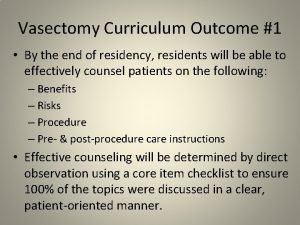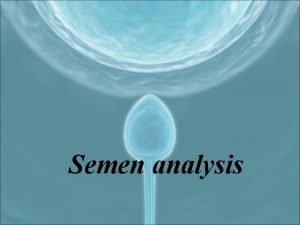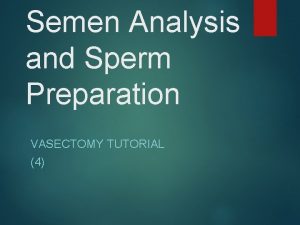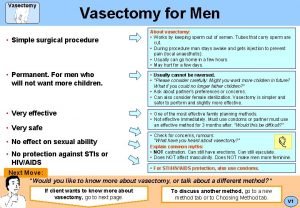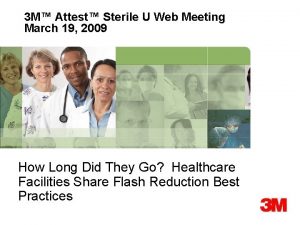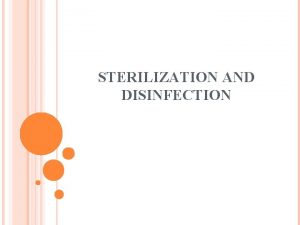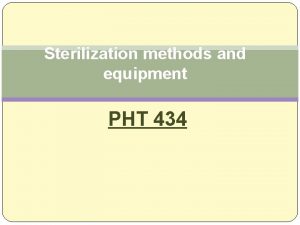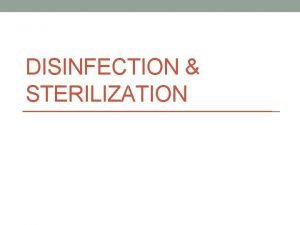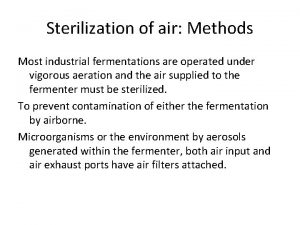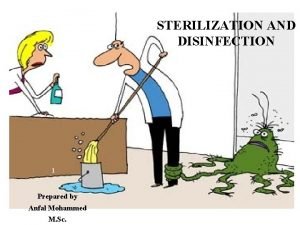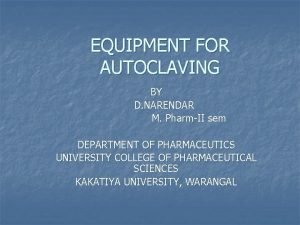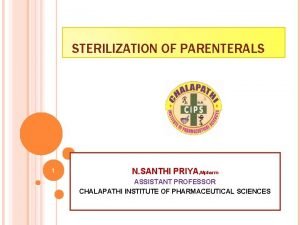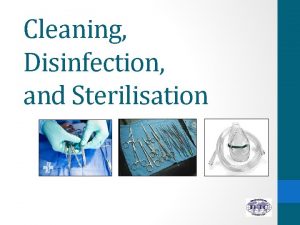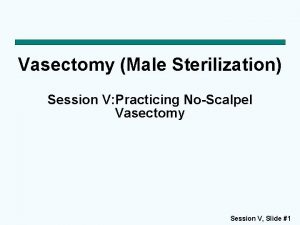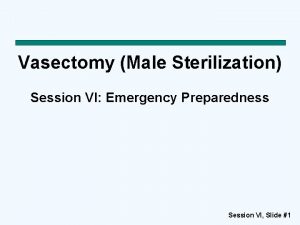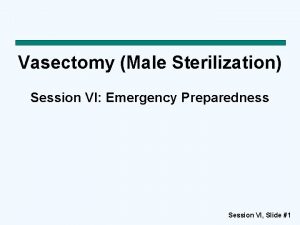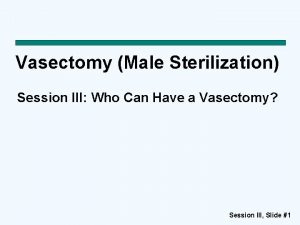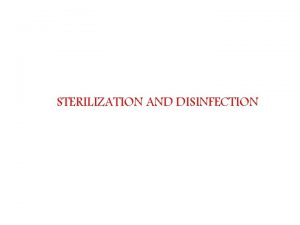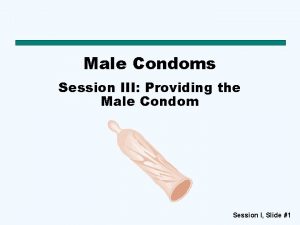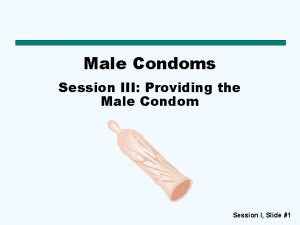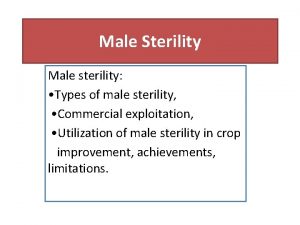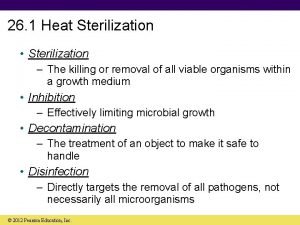Vasectomy Male Sterilization Session IV Providing Vasectomy Session






















- Slides: 22

Vasectomy (Male Sterilization) Session IV: Providing Vasectomy Session IV, Slide #1

Session IV Objectives By the end of this session, participants will be able to: • State when the client can have the vasectomy procedure • Counsel a client for the vasectomy procedure • Effectively counter or correct misunderstandings or misconceptions and rumors about vasectomy in the local settings • List the side effects and the intraoperative, immediate postoperative, and long-term complications associated with vasectomy • Counsel the client about side effects of vasectomy • Describe management of complications and side effects Session IV, Slide # 2

Timing of the Vasectomy Procedure When can a client have a vasectomy? • The procedure can be performed at any time if: – The client has made the request and is prepared. – No medical conditions warrant delay of the vasectomy. – The client has made an informed and voluntary decision (provided written informed consent). – The provider is prepared and ready, with the right equipment and supplies to perform the procedure. • If any of the above conditions are not met, there can be a delay. • The client may need to be referred if he has a condition that needs special attention. Session IV, Slide # 3

Key Counseling Topics for Vasectomy (1) • What the client knows about vasectomy • What vasectomy is and how it works • Permanence—the decision should be carefully considered • Safety and efficacy • Benefits • Information about other available methods Session IV, Slide # 4

Key Counseling Topics for Vasectomy (2) • The vasectomy procedure • Possible side effects and complications • No protection against STIs and HIV • Pre-procedure and post-procedure instructions • Giving informed consent for the procedure Session IV, Slide # 5

Correcting Rumors and Misunderstandings about Vasectomy (1) • What are rumors and misunderstandings or misconceptions? Exercise 1. In rare instances, vasectomy may cause testicular cancer. (True/False) 2. The volume of ejaculate from vasectomized men is always significantly lower than that of non-vasectomized men. (True/False) 3. Vasectomy causes vascular problems for men, especially those who have chronic hypertension. (True/False) 4. Vasectomy is not castration. (True/False) 5. Vasectomy does not interfere with manhood or sexuality in any way. (True/False) 6. It is easier to perform female sterilization on a female client than to perform a vasectomy on a man. (True/False) 7. Vasectomy makes men obese and weak. (True/False) Session IV, Slide # 6

Correcting Rumors and Misunderstandings about Vasectomy (2) Answer Key 1. In rare instances, vasectomy may cause testicular cancer. (False) 2. The volume of ejaculate from vasectomized men is always significantly lower than that of nonvasectomized men. (False) 3. Vasectomy causes vascular problems for men, especially those who have chronic hypertension. (False) 4. Vasectomy is not castration. (True) 5. Vasectomy does not interfere with manhood or sexuality in any way. (True) 6. It is easier to perform female sterilization on a female client than to perform a vasectomy on a man. (False) 7. Vasectomy makes men obese and weak. (False) Session IV, Slide # 7

Correcting Rumors and Misunderstandings about Vasectomy (3) • What are some rumors and misunderstandings about vasectomy? – – – It is castration. It makes the man weak. It makes the man obese. The man cannot ejaculate during intercourse. It interferes with manhood and sexuality. It may cause testicular cancer. • Take steps to correct rumors and misunderstandings about vasectomy. Session IV, Slide # 8

Role Play on Correcting Rumors and Misconceptions Instructions • Each group discusses the script provided and agrees on who will be the client and who will play the role of the provider. • Quickly practice the role play. • Present the role play in plenary. Session IV, Slide # 9

Points of Informed Consent • What is informed consent? • Points of informed consent – – – Temporary methods are available. Vasectomy is a surgical procedure. The procedure has risks and benefits. It prevents the client from having any more children. It is permanent; it cannot be reversed. You can decide against the procedure at any time before surgery. – The method does not protect against HIV and STIs. Session IV, Slide # 10

Verifying Informed and Voluntary Decision Making Just before Surgery Ask the client these questions: STOP CAUTION GO Should not have surgery now Needs more counseling Signs of a sound decision WHO made the decision for sterilization? Someone else Client decided (but partner objects) Client and partner (or client, if single) WHEN did the client decide not to have more children? Now Recently Some time ago WHY did the client choose permanent contraception? Pressure from someone else Belief that permanent method can be reversed Desire for no more children HOW did the client decide? While upset or under stress Without enough consideration or information After consideration and full information Does not know that it: • Is permanent • Is a surgical method • Means he cannot have more children Has some misunderstandings about contraceptive methods Understands that it: • Is permanent • Is a surgical method • Means he cannot have more children Would prefer another method if available Has little knowledge of other methods or their availability Knows of other methods, but prefers permanent contraception WHAT does the client know about vasectomy? WHAT does the client know about other contraceptive methods? Source: Engenderhealth, 2007 Session IV, Slide # 11

Counseling about Possible Side Effects and Intraoperative, Immediate Postoperative, and Long -Term Complications • The client should be informed that vasectomy has very few side effects. • Some of these are transient, such as: – Discomfort, bruising, and slight pain at the operative site; tends to subside with analgesics and rest – Some blood streaks in ejaculate immediately after the procedure • In rare instances, the client may have persistent dull pain for several months after the procedure. • Risks associated with the procedure include the following: – Bleeding and/or accumulation of blood clots – Infection or abscess at the operation site with or without fever, pain – Failure of the method Session IV, Slide # 12

Explaining the Vasectomy Procedure • • You will remain awake throughout the procedure. You will receive a pain-relieving medication. A small opening will be made in the scrotum. The vas (i. e. , the tubes that carry sperm) will be identified, cut, and tied. • The opening will then be closed. • You will be expected to rest for at least half an hour. • If all is well after 30 minutes, you will be discharged. Session IV, Slide # 13

Supporting the Vasectomy User (1) How can a provider support a vasectomy user? • The period for supporting a vasectomy user includes any time before, during, and after the procedure. • It involves self care: – What to do before the procedure (instructions) – What the client should do during the vasectomy procedure – What to do immediately after the procedure – Follow-up visits (scheduled or planned and unscheduled visits) – What to do about most common problems Session IV, Slide # 14

Supporting the Vasectomy User (2) Preoperative instructions • Wear clean, loose-fitting clothing. • Have a bath and ensure that the external genitalia are cleaned well. • Do not shave the operation area. Postoperative instructions • • Loose-fitting pants Snug pants Rest for 2 days. Put cold compresses on the scrotum for the first 4 hours. Wear snug underwear or pants. Keep the puncture site clean and dry for 2– 3 days. Do not have sex for at least 2– 3 days. Use condoms or any other effective contraceptive for 3 months. Use medicine provided for pain. Return to the facility on the specified date. Session IV, Slide # 15

Postoperative Care • NSV is a simple procedure. • It requires short rest period for observation before discharge. • Discharge the client if he is stable and the wound is not bleeding. • Give analgesics for pain. • Give postoperative instructions. • Encourage follow-up visits—scheduled or unscheduled. • Conduct semen analysis. Session IV, Slide # 16

Medical Reasons to Return to the Clinic after Vasectomy • All clients are welcome at any time after vasectomy if: – They have problems or questions. – They experience swelling in the first few hours after surgery. – They have a fever in the first 3 days. – There is pus or bleeding from the wound. – There is worsening pain, heat, and redness of the wound. – The spouse/partner has conceived. Session IV, Slide # 17

Helping the Vasectomy User • Helping vasectomy users entails managing any problems or addressing any concerns after the procedure. • Complications reported include: – – – Bleeding or blood clots after the procedure Wound infection Abscess formation Persistent pain lasting for months after the procedure Emergence of a new medical condition Session IV, Slide # 18

Intraoperative, Immediate Postoperative, and Long-Term Complications of Vasectomy (1) • Side effects What is the most important thing that you can do for a man who complains of problems that you think are transient side effects associated with the vasectomy procedure? Side effects Management or actions to be taken Discomfort, pain, and swelling after the procedure Reassurance, wear snug pants or underwear, use cold compresses, analgesics, rest First ejaculate after procedure may have some blood stains Reassurance Session IV, Slide # 19

Intraoperative, Immediate Postoperative, and Long-Term Complications of Vasectomy (2) • Complications Management/actions needed During the vasectomy procedure Bleeding Intraoperative—use gentle surgical technique, avoid vessels on sheath of vas, inspect surgical site, to identify and ligate/cauterize bleeders. Ensure that there is no bleeding before closing wound. Injury to other structures of the spermatic cord Be careful when conducting procedure. Immediately after the NSV procedure Bleeding and blood clots formation Reassurance that minor bleeding or small uninfected clots usually go away without treatment. Large blood clots need surgical drainage; prevention during surgery is key. Infected blood clots require hospitalization and antibiotics Infection at operation site Counsel, and clean the infected area, Give antibiotics, continue to follow up until infection has resolved. Abscess formation Counsel. Arrange to drain the abscess, clean the area with antiseptic, drain the abscess, Dress wound as appropriate. Give oral antibiotics and analgesics as needed. Return after treatment or there is pain, reddening, heat, or drainage of wound. Session IV, Slide # 20

Intraoperative, Immediate Postoperative, and Long-Term Complications of Vasectomy (3) • Complications Management/actions needed Long after the NSV procedure Sperm granuloma formation Refer for specialized care. Chronic testicular pain or pain Counseling, elevation of the scrotum, soaking in warm lasting for months water, analgesics; provide antibiotics if infection is suspected. If pain persists, refer for more specialized surgical intervention or further management. Pregnancy Counsel, and discuss options available to manage complication. Prevention: Ensure identification and occlusion of vas is done as recommended. Consider repeat vasectomy or other alternative contraceptive methods, etc. Refer spouse to antenatal clinic. Regret and dissatisfaction Counsel client—good counseling is key to prevention of regret. May need to discuss other viable options (e. g. , adoption, assisted reproduction, etc. ) Session IV, Slide # 21

Role Plays and Case Studies Session IV, Slide # 22
 Vasectomy omaha reviews
Vasectomy omaha reviews Oligozoospermia
Oligozoospermia Vasectomy baton rouge
Vasectomy baton rouge Vasectomy vs tubal ligation
Vasectomy vs tubal ligation Vasectomy procedure
Vasectomy procedure Principle of sterilization
Principle of sterilization Tass eye syndrome
Tass eye syndrome Introduction of disinfection
Introduction of disinfection Mechanical method of sterilization
Mechanical method of sterilization Sterilization quality control
Sterilization quality control Advantages of batch sterilization
Advantages of batch sterilization Sterilization by mechanical methods
Sterilization by mechanical methods Physical methods of food preservation
Physical methods of food preservation Nurses responsibility in sterilization
Nurses responsibility in sterilization Performance qualification protocol
Performance qualification protocol Sterilization by mechanical methods
Sterilization by mechanical methods Gamma irradiation sterilization process
Gamma irradiation sterilization process Low temperature sterilization
Low temperature sterilization Ethylene oxide sterilization validation
Ethylene oxide sterilization validation Santhi priya hot
Santhi priya hot Sterilization methods
Sterilization methods Sterilization and disinfection
Sterilization and disinfection Differentiate between disinfection and sterilization
Differentiate between disinfection and sterilization
